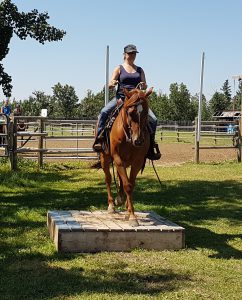Let’s start this off with a hypothetical (or not so hypothetical) situation. You are riding your horse. You want to turn left, but your horse turns right.
Was your horse wrong to do that?
You answered that question in your head almost immediately after you read it, didn’t you? In this three part series, we’re going to dig deep into what is really happening in your horse’s mind, and how we can work with that to achieve a consistently positive outcome – for both of you.
What your answer was depends on how you typically conduct yourself in potentially confrontational situations. There are generally three different responses here. Let’s look at them.
The Concept |
The Response |
| Obedience | The horse is wrong and is ignoring me.The horse requires training / tuning up / reprimand / etc. |
| Acceptance | Sometimes it works out and sometimes it doesn’t. Just laugh about it and move on. |
| Failure | I blame yourself. It has to be my fault! What am I doing wrong?!? |
What would you do? What should we do? We’re going to chat about a fourth option.
Lets start by looking at an indisputable fact:

Whatever your horse does, the have a reason for doing it.
In their mind it is the right thing. A horse’s mind – and then their body, if left to follow a thought – will be drawn to the highest pressure. That might be the gate, a buddy or running in fear. Read my last article on Teaching Horses to Handle Pressure for some great insight on this.
Here is my thought. You’re both right. You have a good reason for wanting to go left and your horse has a good reason for wanting to go right. If, in your mind, the horse is wrong then you’re having a conversation breakdown. This is no different than having a disagreement with a person, and you choosing not to see things their way – if only to understand how their point is valid to them.
Let’s touch on conversation. What is the most important trait of a good conversationalist? That’s right! Being a good listener. In addition to that, one of the most important jobs of a good leader is causing our followers to want to follow us. The solution – our fourth option – then, is a combination of the two.
One of the biggest blunders we can make – and believe me I’ve made it a million times – is not listening to the horse. It happens. You might be on a trail ride with some buddies and focused on your conversation more than you are your horse. They might be giving you subtle signs, but you’re not picking them up because you’re fixated on your friend’s tale of Facebook drama.
The good thing though, is that we can remedy this easily. The horse has a simple language that doesn’t take us long to learn. If, that is, we commit to learning it.
Let’s look at our example again. We desire a left turn. For that to be successful, we need the following:
- Knowledge of where our our horse’s mind is. If they’re under pressure, thinking of escape routes, thinking of a buddy or just about anything else, then one fact is clear: they are NOT thinking of following our focus.
- We must present a focus that the horse can follow in the first place. If we don’t provide something to follow then we’re not leading. If we’re not leading, it should be no surprise that our horses do what they want. And in my mind, they’re justified in doing so. Watch my Horsemanship Top Ten video on Situational Awareness to learn more.
Learning to communicate in the language of the horse is a prerequisite to riding, training and coaching. What I’ve found is that factual knowledge of the horse’s body and mind generally doesn’t find it’s way into conventional conventional rider and horse training. We’re taught a lot of ‘how’ but not a lot of ‘why’.
Without knowledge, horses are washed out of training programs because they’re misunderstood. Riders become frustrated. Let’s change that up.
Stay tuned for Part Two to figure out how we take this dilemma to a great outcome!
Scott Phillips
April 2018
